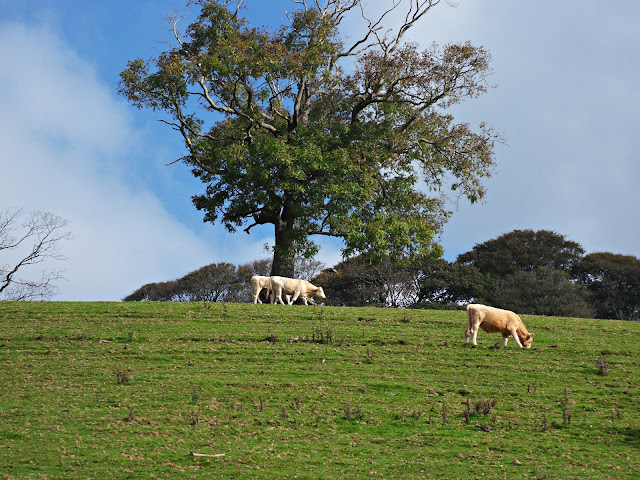and a church with Celtic crosses.
We parked our car at Lerryn and crossed the River Lerryn using the stepping stones (right) - this can only be done when the tide is low as the river is tidal. The alternative is to use the 500+ year old bridge as per the photo at the top of the post.
Once to the other side. it's initially just a matter of following the path alongside the river.
The path soon ends and into the woods we go, still easy going. I guess the total length of the walk is just over five miles.
As the path through the woods steepens there are lovely views over the river (below).
As the woods fade away we have to hop, well climb, over the style and into a farmer's fields.
There are often cows or other animals roaming about but this is a public right of way, so they no doubt get used to walkers.
We leave the River Lerryn behind as it becomes the River Fowey but continue walking along the bank as we are nearly at St.Winnow.
We reach St.Winnow and head into the church where there are some lovely examples of Celtic crosses.
St.Winnow Church was founded in the 7th century and was mentioned in the Domesday Book of 1086.
St.Winnow, or St. Winnoc, was an evangelist who set up many churches and died around 717 AD. The church tower was most likely added in the 15th century.
The church itself found a fame back in the mid to late 1970s when it featured in the first series of television's Poldark, based on the books by Winston Graham, which were set in Cornwall in the 1700s.
When following this walk we often sit for a while in the churchyard. It's pleasant to look across the river - more Celtic crosses - though it turned a little hazy.
While at the church I noticed an old memorial (as above) to Sir William Sawle who died on the 16th of February 1651. The verse reads:
When I was sick most men did deem me ILL
If I had lived I should have been so still
Praised be the Lord, that in the Heavens doth dwell
Who hath received my soul, now I AM WELL
Then it's off again into a farmer's field with a well trodden path.
Nice to look back at the river and the animals in the fields.
Now it's back into the woods along an easy path.
Once finally out of the woods there are more fields, with many fine old oak trees - until we eventually return to the stepping stones / bridge.
Yes, a very pleasant easy walk.







































